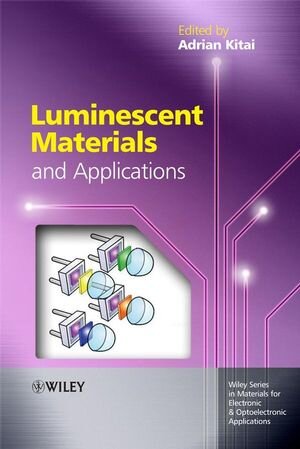
×
![Buchcover ISBN 9780470985670]()
Luminescent Materials and Applications
herausgegeben von Adrian KitaiLuminescence, for example, as fluorescence, bioluminescence, andphosphorescence, can result from chemical changes, electricalenergy, subatomic motions, reactions in crystals, or stimulation ofan atomic system. This subject continues to have a majortechnological role for humankind in the form of applications suchas organic and inorganic light emitters for flat panel and flexibledisplays such as plasma displays, LCD displays, and OLEDdisplays.
Luminescent Materials and Applications describes a widerange of materials and applications that are of current interestincluding organic light emitting materials and devices, inorganiclight emitting diode materials and devices, down-conversionmaterials, nanomaterials, and powder and thin-filmelectroluminescent phosphor materials and devices. In addition, both the physics and the materials aspects of the field ofsolid-state luminescence are presented. Thus, the book may be usedas a reference to gain an understanding of various types andmechanisms of luminescence and of the implementation ofluminescence into practical devices.
The book is aimed at postgraduate students (physicists, electricalengineers, chemical engineers, materials scientists, and engineers)and researchers in industry, for example, at lighting and displaycompanies and academia involved in studying conduction in solidsand electronic materials. It will also provide an excellentstarting point for all scientists interested in luminescentmaterials. Finally it is hoped that this book will not onlyeducate, but also stimulate further progress in this rapidlyevolving field.
Luminescent Materials and Applications describes a widerange of materials and applications that are of current interestincluding organic light emitting materials and devices, inorganiclight emitting diode materials and devices, down-conversionmaterials, nanomaterials, and powder and thin-filmelectroluminescent phosphor materials and devices. In addition, both the physics and the materials aspects of the field ofsolid-state luminescence are presented. Thus, the book may be usedas a reference to gain an understanding of various types andmechanisms of luminescence and of the implementation ofluminescence into practical devices.
The book is aimed at postgraduate students (physicists, electricalengineers, chemical engineers, materials scientists, and engineers)and researchers in industry, for example, at lighting and displaycompanies and academia involved in studying conduction in solidsand electronic materials. It will also provide an excellentstarting point for all scientists interested in luminescentmaterials. Finally it is hoped that this book will not onlyeducate, but also stimulate further progress in this rapidlyevolving field.



